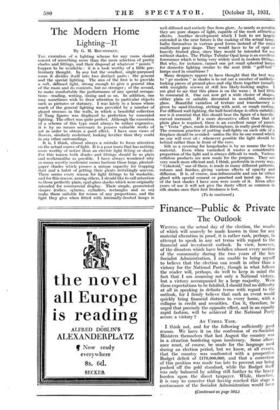The Modern Home
Lighting—II
By G. M. BOUMPHREY.
Tun execution of a lighting 'scheme . for any room should consist of something more than the mere selection of pretty shades and fittings, and their disposal at whatever " points ' happen to be available it is a task worthy of a little pre- liminary thought. In any but the smallest, single-purposed room it divides itself into two distinct parts : the general and the special lighting. The aim of the first is to provide a soft, diffused light, strong enough to give a general idea of the room and its contents, but no stronger ; of the second, to make comfortable the performance of any special occupa- tions—reading, writing, dining and so on. In addition, one may sometimes wish to draw attention to particular objects such as pictures or statuary. I was lately in a house where much of the general lighting was provided by a number of glazed recesses in the walls, in which a beautiful collection of Tang figures was displayed to perfection by concealed lighting. The effect was quite perfect. Although the execution, of a scheme of this type must always be rather expensive, it is by no means necessary to possess valuable works of art in order to obtain a good effect. I have seen vases of flowers, similarly enshrined, looking lovelier than they could in any other surroundings.
It is, I think, almost always a mistake to focus attention on the actual source of light. It is a poor room that has nothing. more worthy of notice than an electric light fitting or shade. For this reason both shades and fittings should be as plain and workmanlike as possible. I have always wondered why so many overtly modernist rooms harbour those large, pleated- paper shades which possess a unique capacity .for trapping dust and a habit of getting their pleats irritatingly uneven. There seems every reason for light fittings to be washable, and for this reason, among ()fliers, I should like to call attention to those perfectly plain, opal-glass shades which were originally intended for commercial display. Their simple, geometrical shapes (cubes, spheres, cylinders, rectangles and so on) make them suitable for rooms of any proportions, and the light they give when fitted with internally-frosted lamps is
well diffused and entirely free from glare, As nearly as possible they are pure shapes of light, capable of the most attractive. effects. Another development which I look to see largely extended in the near future is the making of the actual lamp. bulbs themselves in various good forms instead of the usual malformed pear shape. They would have to be of opal or heavily frosted glass, since they would be intended for use without shades. The Philips Tubular Opal lamp is an excellent forerunner which is being very widely used in modern fittings. But why, for instance, cannot one get small spherical lamps for domestic lighting similar to the neat little " golf-ball " lamps used in omnibuses ?
Many designers appear to have thought that the best way to " go modern " in shades is to cut out a number of unlikely. looking pieces of ground-glass and clip them together (usually with unsightly screws) at still less likely-looking angles. I am glad to see that this phase is on the wane : it had little to commend it. One can now get a wide choice of shapes, either plain or suitably decorated in moulded, obscured glass. Beautiful variation of texture and translucency is given by sand-blasting, etching with acid, or rough casting. For diffused wall-lighting, the half-bowl shape is often suitable; nor is it essential that this should bear the figure of a heavily- curved mermaid. If a more decorative effect than that of plain glass is required, there is an excellent range of panels in " Vesta " glass, made in Birmingham, in really good designs. The common practice of putting wall-lights on each side of a fireplace should be avoided—unless the fire be one round which no one will ever sit : whenever possible the light should be behind rather than in front of the eyes. Silk as a covering for lampshades is by no means the best material. Even when varnished it wastes a considerable proportion of the light and is always difficult to wash. Various cellulose products are now made for the purpose. They are very much more efficient and, I think, preferable in every way. " Celastoid," one of these, is made in many different patterns, colours and finishes, giving various effects of opacity and diffusion. It is, of course, non-inflammable and can be either glued with special cement or punched and laced up. Some of the best shades I have seen were made of it. Even after years of use it will not give the dusty effect so common in silk shades once their first freshness is lost.
(To be continued.)






































 Previous page
Previous page